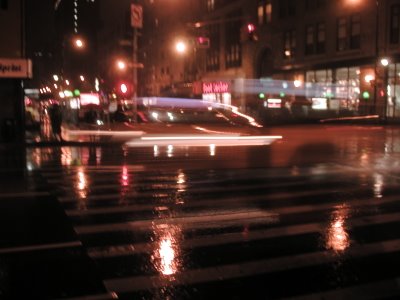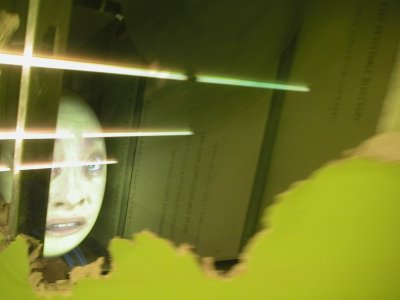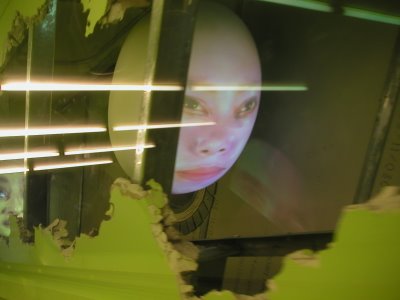Saturday, September 30, 2006
Replacing Good Design With Bad
 Good graphic design in consumer goods isn't always easy to come by. When I see something well-packaged, a shallow part of me wants to own it just so I can look at it. Warhol couldn't have done what he did with a soup can if Campbell's hadn't come up with such a well-constructed label. There are lots of mundane products with very satisfying labels out there, and sometimes, the labels add to the product's cachet. A good example of this was (notice I say was) the label of a brand of Brazilian Cachaça, shown at left. Cachaça is a sugar cane liquor similar to rum and tequila. It's trendy right now for the Caipirinha, a mixture of cachaça with lime and sugar.
Good graphic design in consumer goods isn't always easy to come by. When I see something well-packaged, a shallow part of me wants to own it just so I can look at it. Warhol couldn't have done what he did with a soup can if Campbell's hadn't come up with such a well-constructed label. There are lots of mundane products with very satisfying labels out there, and sometimes, the labels add to the product's cachet. A good example of this was (notice I say was) the label of a brand of Brazilian Cachaça, shown at left. Cachaça is a sugar cane liquor similar to rum and tequila. It's trendy right now for the Caipirinha, a mixture of cachaça with lime and sugar. This isn't the only brand of cachaça, but it's one of the most common. I think the name of it is PIRASSUNUNGA 51. The label is beautiful. It invokes a fifties glamor, maybe even a pre-Castro Cuban style aesthetic. There are layers to the design, and the script is fabulous. The colors are satisfying together. The biege-ish color is surprising when offset by the yellow, black, gold, and red. But something happened:
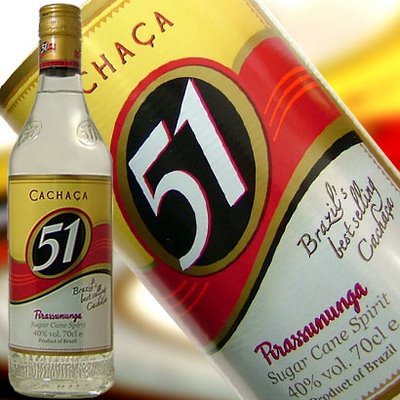 Maybe someone decided that they'd had that label for forty or fifty years and it was time for a new one. I respect that, but do it right. This isn't an update, this is a desecration. The biggest problem with this new label, the single thing that ruins it, is the typeface for the word "Cachaça." It's completely wrong in style, in size, and in thickness. It doesn't match anything else on the label. This was a mistake for the company, one a shallow, design-motivated hipster like me may respond to by moving to a more satisfying label. I present PITU:
Maybe someone decided that they'd had that label for forty or fifty years and it was time for a new one. I respect that, but do it right. This isn't an update, this is a desecration. The biggest problem with this new label, the single thing that ruins it, is the typeface for the word "Cachaça." It's completely wrong in style, in size, and in thickness. It doesn't match anything else on the label. This was a mistake for the company, one a shallow, design-motivated hipster like me may respond to by moving to a more satisfying label. I present PITU: 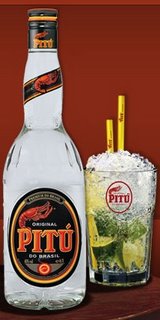 Isn't the lobster motif wonderful?
Isn't the lobster motif wonderful?  Here's another example. I bought a DVD of one of my favorite horror comedies recently -- Ken Russell's 1988 classic The Lair of the White Worm. It's a strange tale starring Hugh Grant, in which an ancient cult based on a giant prehistoric worm-like thing causes mayhem in a small English town. Amanda Donohoe is excellent as the freaky worm-worshipper Lady Sylvia Marsh. The original movie poster and subsequent VHS box had a great design. That's Donohoe coming out of a basket, snake charmer style. The arabesque swirly background is perfect for it -- it says exotic camp, which is just what the movie is. But now look at what they've done. I don't need to show you a large picture of the new cover because there's not much to see. Just a huge blue Hugh Grant, dominating the once enchanting design.
Here's another example. I bought a DVD of one of my favorite horror comedies recently -- Ken Russell's 1988 classic The Lair of the White Worm. It's a strange tale starring Hugh Grant, in which an ancient cult based on a giant prehistoric worm-like thing causes mayhem in a small English town. Amanda Donohoe is excellent as the freaky worm-worshipper Lady Sylvia Marsh. The original movie poster and subsequent VHS box had a great design. That's Donohoe coming out of a basket, snake charmer style. The arabesque swirly background is perfect for it -- it says exotic camp, which is just what the movie is. But now look at what they've done. I don't need to show you a large picture of the new cover because there's not much to see. Just a huge blue Hugh Grant, dominating the once enchanting design.  Donohoe is now on the margin and the eye-popping background is gone. Grant sells movies, so they blew him up. Better, they must have thought (that elusive "they" -- who are they?), to trick young fans of Grant into buying a creepy kitschy Ken Russell movie than to leave the cover as it was and attract viewers who might like the movie.
Donohoe is now on the margin and the eye-popping background is gone. Grant sells movies, so they blew him up. Better, they must have thought (that elusive "they" -- who are they?), to trick young fans of Grant into buying a creepy kitschy Ken Russell movie than to leave the cover as it was and attract viewers who might like the movie. The lesson is this: don't change something because it's old. Change it for other reasons. And when you do, do it right. Think about it. Good design will endure, whether you want it to or not.
Cute Animals, Little People, Dead Animals, Edible Animals, And More
My friend Kyle at the blog Kyle's Best of the Blank has a brilliant post titled: "This Could Make Our Country Great Again" about Baby Toupees.
Kyle seems to be on some kind of a cuteness bender. Check out his link to animals in casts -- so pathetic, so cute that, as Kyle says "I want to squeeeeeze it."
He found a video clip from what looks like a Bollywood movie in which a strange little person does some alarmingly smooth b-boy moves while a lounging mustachioed man in a sleeveless shirt stops and starts the music. It's mezmerizing. I just watched it again.
Now I've had too much cute, so I go to my friend Mike's blog, "Greetings From the Top of the World." Mike is a math professor who just moved to Barrow, Alaska, the northern-most point in America. I think it's above the Arctic Circle. In his most recent entry, he says there's not much to do there, so he does lots of push-ups. He also walks on the tundra. So where's my cuteness antidote? Ah, there it is: "Whaling Season Opens Today." Here's what Mike has to say about it:
Now I need an antidote to Mike's dog-eating post. For that, I follow a link I found in one of his reader's comments. It leads me to this: "Get Behind Jesus," which offers this:
From my good friend K, I learned about an agency in Germany that sends people, via phone or a messenger, break-up news. Why not? A break-up service is in a way, a logical (if idiotic) outgrowth of dating services.
Now I'm depressed. I need cute again, only this time with a twist. How about pandas? I first heard about this "incident" via Gothamist:
Man is drunk at zoo. Man sees cute panda. Man climbs into panda habitat. Man sneaks up on panda, hugs him. Panda bites man; man bites panda. Man gets stiches, panda confused.
It happened in Beijing when Zhang Xinyan, 35, drank too much and figured six year-old Gu Gu needed some affection. According to the BBC, the man told reporters: "I bit the panda on its back but its fur was too thick. ... No one ever said they would bite people. I just wanted to touch it." Yes. That'll do.
Kyle seems to be on some kind of a cuteness bender. Check out his link to animals in casts -- so pathetic, so cute that, as Kyle says "I want to squeeeeeze it."
He found a video clip from what looks like a Bollywood movie in which a strange little person does some alarmingly smooth b-boy moves while a lounging mustachioed man in a sleeveless shirt stops and starts the music. It's mezmerizing. I just watched it again.
Now I've had too much cute, so I go to my friend Mike's blog, "Greetings From the Top of the World." Mike is a math professor who just moved to Barrow, Alaska, the northern-most point in America. I think it's above the Arctic Circle. In his most recent entry, he says there's not much to do there, so he does lots of push-ups. He also walks on the tundra. So where's my cuteness antidote? Ah, there it is: "Whaling Season Opens Today." Here's what Mike has to say about it:
Three of the crews brought in whales. This is considered spectacular for the first day. They bring them to the beach to be butchered. They are all ready done as I write. That was a lot of work. I saw loads of fresh cut whale meat zooming down the street in trailers and being hauled by ATV's. It looks remarkably like huge slices of watermelon.That may be enough to get me off cute. But just to make sure, I'll check out the post where he meets a Filipino guy who tells him about eating dogs and cock fighting. I'll let you find that post on your own. It's been fun to read about Mike's adjustment to the North. He posts some good pictures, too.
Now I need an antidote to Mike's dog-eating post. For that, I follow a link I found in one of his reader's comments. It leads me to this: "Get Behind Jesus," which offers this:
Angus MacDougall is a three-year-old terrier mix that has recently been blessed with the revered and holy image of Jesus Christ on his hindquarters. Is this manifestation of The Prince of Peace a coincidence or a bona fide miracle?I suggest you push the "click here for a miracle" button.
From my good friend K, I learned about an agency in Germany that sends people, via phone or a messenger, break-up news. Why not? A break-up service is in a way, a logical (if idiotic) outgrowth of dating services.
Now I'm depressed. I need cute again, only this time with a twist. How about pandas? I first heard about this "incident" via Gothamist:
Man is drunk at zoo. Man sees cute panda. Man climbs into panda habitat. Man sneaks up on panda, hugs him. Panda bites man; man bites panda. Man gets stiches, panda confused.
It happened in Beijing when Zhang Xinyan, 35, drank too much and figured six year-old Gu Gu needed some affection. According to the BBC, the man told reporters: "I bit the panda on its back but its fur was too thick. ... No one ever said they would bite people. I just wanted to touch it." Yes. That'll do.
Staten Island
 I went to beautiful, conservative Staten Island with a friend a couple weeks ago. The ferry was fun, and the crowds were big. The Staten Island minor league Yankees were playing a game at the stadium on the shore overlooking Manhattan. It looks like a great place to watch a game. Didn't stay for it though. But now I can say I've been to all the five boroughs.
I went to beautiful, conservative Staten Island with a friend a couple weeks ago. The ferry was fun, and the crowds were big. The Staten Island minor league Yankees were playing a game at the stadium on the shore overlooking Manhattan. It looks like a great place to watch a game. Didn't stay for it though. But now I can say I've been to all the five boroughs. 
Three Over-used Literary References Give Me a Reason to Bad-mouth Things I Don't Like Anyway
I'd like to rant how annoying I think it is when people over-use literary references. Smart people do it, even at the most inappropriate times. Mention Brooklyn in any context and half the people who don't live here will say something about trees growing here. God forbid you mention a park in Brooklyn -- then people go nuts with excitement: so trees really do grow in Brooklyn! Hahahaha!
This is an unsophistcated reference to Betty Smith's 1943 book (called A Tree Grows in Brooklyn if you haven't figured it out yet) about a poor Brooklyn girl in 1912. The tree metaphor starts on page one: a tree with such a will to survive that its seeds grow through cement. And yes, the little girl is like the tree. Now you don't have to read it. It's sounds like a triumphant book, which means I'll never read it; triumphant books, like most self-described "feel-good-movie(s)-of-the-year, are too much for my cynical soul to bear. I picture the earnest praise from young single women's book clubs and I go numb.
Another insufferable reference is the one where someone waits a long time for something, or says he or she is waiting. This elicits the obligatory "Waiting for Godot" mention. Now is a good time to mention how awful I thought that play was. (I suppose it's only fair to mention that I only read the play -- I haven't seen it performed.) I think it's self-indulgent and patronizing and boring and I don't know which irritates me more: the play or its superior champions, most of whom only pretend to "get it."
Samuel Beckett's Waiting for Godot opened in Paris in 1953. Most critics were nonplussed. The secret though, is there's nothing to understand. Don't look for hidden meaning; Beckett's intellectual trickery is that there are no tricks. Two idiots wait for a guy who never had any intention of showing up. End of play. Any reference to this play in polite conversation reminds me that though modern theater needed a moment like this -- just as art needed Duchamp's ready-mades and music needed John Cage's infamous 4' 33" (four minutes and 33 seconds of silence that debuted just one year before Beckett's play: hey, listen, I'll play it for you right now.) -- that moment should not be dwelled upon.
My final rant is against though who would reference a certain biblical tale whenever a person walks into a room: "Aha! The prodigal son returns! Hahahahaha!" The story is from the Gospel of Luke. It's about a guy with two sons. One is good. He does what he's supposed to do. The other is a jerk. He spends everything and then begins to starve, so he repents and offers to be his dad's servant. The dad rejoices (because the estranged son came back to his family) and treats him like a prince, while the other son gets mad because he feels like he's been taken for granted for being too predictably and consistently good.
The moralizing Minnesota Scandinavian Lutheran in me says that the father acts as any sentimental father might, but that he's doing his son a disservice by refusing to let his son do penance. To invoke the parable of the prodigal son when your spouse returns from a trip to the grocery store, as people so recklessly do these days, is bizarre; it cheapens the parable and insults the returner.
This is an unsophistcated reference to Betty Smith's 1943 book (called A Tree Grows in Brooklyn if you haven't figured it out yet) about a poor Brooklyn girl in 1912. The tree metaphor starts on page one: a tree with such a will to survive that its seeds grow through cement. And yes, the little girl is like the tree. Now you don't have to read it. It's sounds like a triumphant book, which means I'll never read it; triumphant books, like most self-described "feel-good-movie(s)-of-the-year, are too much for my cynical soul to bear. I picture the earnest praise from young single women's book clubs and I go numb.
Another insufferable reference is the one where someone waits a long time for something, or says he or she is waiting. This elicits the obligatory "Waiting for Godot" mention. Now is a good time to mention how awful I thought that play was. (I suppose it's only fair to mention that I only read the play -- I haven't seen it performed.) I think it's self-indulgent and patronizing and boring and I don't know which irritates me more: the play or its superior champions, most of whom only pretend to "get it."
Samuel Beckett's Waiting for Godot opened in Paris in 1953. Most critics were nonplussed. The secret though, is there's nothing to understand. Don't look for hidden meaning; Beckett's intellectual trickery is that there are no tricks. Two idiots wait for a guy who never had any intention of showing up. End of play. Any reference to this play in polite conversation reminds me that though modern theater needed a moment like this -- just as art needed Duchamp's ready-mades and music needed John Cage's infamous 4' 33" (four minutes and 33 seconds of silence that debuted just one year before Beckett's play: hey, listen, I'll play it for you right now.) -- that moment should not be dwelled upon.
My final rant is against though who would reference a certain biblical tale whenever a person walks into a room: "Aha! The prodigal son returns! Hahahahaha!" The story is from the Gospel of Luke. It's about a guy with two sons. One is good. He does what he's supposed to do. The other is a jerk. He spends everything and then begins to starve, so he repents and offers to be his dad's servant. The dad rejoices (because the estranged son came back to his family) and treats him like a prince, while the other son gets mad because he feels like he's been taken for granted for being too predictably and consistently good.
The moralizing Minnesota Scandinavian Lutheran in me says that the father acts as any sentimental father might, but that he's doing his son a disservice by refusing to let his son do penance. To invoke the parable of the prodigal son when your spouse returns from a trip to the grocery store, as people so recklessly do these days, is bizarre; it cheapens the parable and insults the returner.
Friday, September 29, 2006
Charles McCarry's The Miernik Dossier
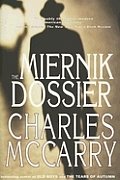 I’m reading another spy novel by former deep cover CIA agent Charles McCarry (see earlier blog on Old Boys) – it’s actually his first one: The Miernik Dossier, published first in 1973. It takes place in about 1959, and , roughly, it’s about a group of Geneva, Switzerland-based spies of American, British, French, and Polish nationalities, along with a six feet, eight inch-tall Sudanese Muslim prince named Kalash el Khatar, a character who appears in McCarry’s most recent book, Old Boys, set more than 40 years later.
I’m reading another spy novel by former deep cover CIA agent Charles McCarry (see earlier blog on Old Boys) – it’s actually his first one: The Miernik Dossier, published first in 1973. It takes place in about 1959, and , roughly, it’s about a group of Geneva, Switzerland-based spies of American, British, French, and Polish nationalities, along with a six feet, eight inch-tall Sudanese Muslim prince named Kalash el Khatar, a character who appears in McCarry’s most recent book, Old Boys, set more than 40 years later. In this story, some of the agents, none of whom will admit to each other his agent-hood, accompany el Khatar on a trip to deliver a new Cadillac to his father in Sudan. This is but a pretense for lots of intrigue – naturally – both within the novel and on a plot-level.
There’s a strange scene halfway through the book where the group is having dinner in Verona, Italy (home, if I’m not mistaken, to the Romeo and Juliet saga). There’s a group of Germans at the next table, and they’re acting superior. “Waffen SS,” says the British agent to the American one. “Returning to the happy scenes of wartime duty.”
A violinist who our group identifies somehow as a concentration camp survivor entertains the German table. The Germans treat him in a way that reminds me of former Southern American slave owners to free blacks in other stories: he’s a minstrel to them, and sadly, the violinist plays the part eagerly.
Tadeusz Miernik, the Polish (probable) spy the book is named for, is not amused:
Miernik’s chair went over backwards. He was standing and speaking to the Germans. He held a table knife in his hand. The Germans stood their ground, either astonished by this display of bad manners or unfrightened by a one-armed man [Miernik wore a cast] with a dull knife. One of the German women carried a Pekingese in her arm; throughout the meal and the violin concert she had been feeding it and talking to it.Upon which the Germans leave, the dog lady sobbing, and Miernik pours more wine for his friends. It’s the strangest scene. The irony is completely lost on the Germans.
“One moment,” Miernik said. “I want to kill your dog.” The woman shrieked, and a lok of real horror came into her eyes. Her husband stepped between the dog and Miernik. “You are drunk,” he said.
“Quite sober,” Miernik said. “Hand over the dog. We have been watching you and we have our orders. The dog must die.”
The German turned on his heel and began to herd his friends toward the door. “Halt!” Miernik shouted. “Come back or I shoot.” The Germans stopped and turned around again—all except the woman with the dog. She now had both arms around the animal. She stared at Miernik over her hunched shoulder. “You are insane,” she cried.
“How long have you been hiding this dog?” Miernik asked in the loud German he was speaking. “Speak up—and remember there are witnesses present.”
“Who are you,” asked the German. “You are not a German.”
“My name does not matter. It is enough that you know that I am an officer in the Dog Death Brigade. You have forgotten that dogs are not human beings. They are dogs. Dogs. Dogs who are shitting on our sacred soil, taking food from the mouths of good human children.”
The violinist looked from Miernik to the Germans, and his giggle changed to a spasmodic, snorting laugh. He had heard this sort of talk somewhere else. With his hand over his mouth, he scuttled away, the thousand-lira note [a tip from the Germans] fluttering to the floor behind him.
“If you did not have that arm in a sling,” the German said, “I would slap your face for you.”
“I don’t doubt it for a moment,” Miernik said. “Your late leader, Reichsführer Himmler, would do practically anything to protect a dog. He may be dead, but the kingdom of his ideas lives on. Take your dog and go. But remember: one day soon the gutters will run red with the blood of dogs.”
Tuesday, September 26, 2006
The Ghostbuster Building
 A friend told me she was sure the apartment building in the classic 1984 film Ghostbusters wasn't a real place. It is. It was made to look much larger in the movie, and certain Gate Keeper / Key Master-shaped gargoyles were added, but the building is real. It's at 55 Central Park West across the street from Central Park's Tavern on the Green (where Rick Moranis runs to and smears his hands on the windows before becoming possessed by the hellhound).
A friend told me she was sure the apartment building in the classic 1984 film Ghostbusters wasn't a real place. It is. It was made to look much larger in the movie, and certain Gate Keeper / Key Master-shaped gargoyles were added, but the building is real. It's at 55 Central Park West across the street from Central Park's Tavern on the Green (where Rick Moranis runs to and smears his hands on the windows before becoming possessed by the hellhound). According to New York Magazine, the Art Deco building was built in 1930. Real Estate agents call it "second tier" and "run-of-the-mill luxury" these days, but the penthouses up top are fabulous. One penthouse, a 4,500 square feet apartment once occupied by Calvin Klein, is empty, but owned by Steve Gottlieb of TVT Records. He was offered $20 million for it, but won't sell. Diane Sawyer and husband Mike Nichols tried to buy it but Gottlieb beat them to it.
The fire station that the Ghostbusters HQ was in is real, too. It's a working station in TriBeCa at 14 North Moore Street. I'll go find that later.
Nebraska Well-Represented in New York
 I found myself at an Irish bar in Hell's Kitchen last Saturday night, surrounded by crazed Nebraskans. I learned they gather there to watch football, University of Nebraska Cornhuskers football. New York truly has everything. The bar -- the "Irish Rogue" -- hosts these Nebraska Society of New York events frequently. I tried to find such a group for the University of Minnesota once. There was such a thing, but the website (which isn't nearly as slick as Nebraska's) hasn't been updated in three years. The link to the bar U of M sports fans appraently watched games was a dead end. How is it Nebraska's so organized and we're not?
I found myself at an Irish bar in Hell's Kitchen last Saturday night, surrounded by crazed Nebraskans. I learned they gather there to watch football, University of Nebraska Cornhuskers football. New York truly has everything. The bar -- the "Irish Rogue" -- hosts these Nebraska Society of New York events frequently. I tried to find such a group for the University of Minnesota once. There was such a thing, but the website (which isn't nearly as slick as Nebraska's) hasn't been updated in three years. The link to the bar U of M sports fans appraently watched games was a dead end. How is it Nebraska's so organized and we're not?
How Many Rats Are There in New York?
One rat for every person in New York City? It's myth, says the New York Times. Yeah, I believe that it's myth -- I would have thought that the number is much higher. If I read that there were 10 rats here for every New Yorker, I'd believe it. But that's not what the paper is saying at all:
This reminds me of a misunderstanding a friend told me about years ago. He and another guy were talking about prostitution and the other guy quotes a statistic he'd read saying something like one in four American men had paid for sex. My friend, thinking that that number was way too high, said "No way! I don't believe it." The other guy says, "Yeah, that's way too low!" My friend was dumbfounded.
Why did these two have such different ideas about how common visits to hookers are in the U.S.? The guy who thought most men visit ladies of the night at least once in their lives served in the Army, where such behavior is common (or at least it was for this guy).
 I haven't read Sullivan's book, but a statistic commonly quoted from it says that "Male and female rats may have sex twenty times a day. A female can produce up to twelve litters of twenty rats a year: one pair of rats has the potential for 15,000 descendants in a year." And they don't outnumber us? His book's full title is Rats: Observations on the History and Habitat of the City's Most Unwanted Inhabitants. In an
I haven't read Sullivan's book, but a statistic commonly quoted from it says that "Male and female rats may have sex twenty times a day. A female can produce up to twelve litters of twenty rats a year: one pair of rats has the potential for 15,000 descendants in a year." And they don't outnumber us? His book's full title is Rats: Observations on the History and Habitat of the City's Most Unwanted Inhabitants. In an
interview with online bookseller Powells, Sullivan said:
There was a great article in the Times in August about a pair of dogs (owned by different people) who hunt rats and mice on New York's Upper West Side. The dogs -- a big Labrador/Pit Bull named Oscar and a tiny Cairn terrier named Paxil gleefully stalk, flush out, and slaughter rats and mice in garbage piles and alleys. When I looked for the article, the Times insisted I pay $5 to read it. Fortunately, big pharma has come to the rescue. A blog, called "Online Paxil News Blog", posted the full article: "The Starsky and Hutch of West 74th Street", presumably because the little dog's name is Paxil. I'm guessing the autobots that feed the blog don't care if the news isn't about drugs.
Some good passages from the article:
As Robert Sullivan noted in his 2004 book, "Rats," a naturalist named David E. Davis analyzed New York's rat population in 1949 and called the one-rat-per-human statistic absurd. (The statistic had come from 19th-century England and was never more than a guess.)But with all the garbage in New York, isn't there an endless supply of food?
This reminds me of a misunderstanding a friend told me about years ago. He and another guy were talking about prostitution and the other guy quotes a statistic he'd read saying something like one in four American men had paid for sex. My friend, thinking that that number was way too high, said "No way! I don't believe it." The other guy says, "Yeah, that's way too low!" My friend was dumbfounded.
Why did these two have such different ideas about how common visits to hookers are in the U.S.? The guy who thought most men visit ladies of the night at least once in their lives served in the Army, where such behavior is common (or at least it was for this guy).
 I haven't read Sullivan's book, but a statistic commonly quoted from it says that "Male and female rats may have sex twenty times a day. A female can produce up to twelve litters of twenty rats a year: one pair of rats has the potential for 15,000 descendants in a year." And they don't outnumber us? His book's full title is Rats: Observations on the History and Habitat of the City's Most Unwanted Inhabitants. In an
I haven't read Sullivan's book, but a statistic commonly quoted from it says that "Male and female rats may have sex twenty times a day. A female can produce up to twelve litters of twenty rats a year: one pair of rats has the potential for 15,000 descendants in a year." And they don't outnumber us? His book's full title is Rats: Observations on the History and Habitat of the City's Most Unwanted Inhabitants. In an interview with online bookseller Powells, Sullivan said:
"We think rats are disgusting, but they're not. They're just another creature. It's not their fault they live in our garbage. In fact, our garbage is our fault, if there's any fault. The reason people are so disgusted by rats is that rats point to what is disgusting about us. We always have to have something bad in our sights to highlight our goodness. You need evil so that good can exist. Really, in nature, it can seem evil, but it's not."
There was a great article in the Times in August about a pair of dogs (owned by different people) who hunt rats and mice on New York's Upper West Side. The dogs -- a big Labrador/Pit Bull named Oscar and a tiny Cairn terrier named Paxil gleefully stalk, flush out, and slaughter rats and mice in garbage piles and alleys. When I looked for the article, the Times insisted I pay $5 to read it. Fortunately, big pharma has come to the rescue. A blog, called "Online Paxil News Blog", posted the full article: "The Starsky and Hutch of West 74th Street", presumably because the little dog's name is Paxil. I'm guessing the autobots that feed the blog don't care if the news isn't about drugs.
Some good passages from the article:
"Paxil and Oscar do their hunting late at night, during their last walks of the day. They began their crusade a couple of years ago, when they met in Riverside Park and prey was abundant. Paxil is an expert at flushing rats out of their hiding places. When she does, if they're small enough, she'll grab one and shake it until its neck snaps."And:
"In the two years they've been hunting, Paxil has dispatched nine rats, and mice beyond counting. Oscar's tally is 22. Not an enormous number altogether, but for them I don't think it's as much about exterminating as about hunting. Both have the instinct built into their breeds, and merely follow the urge to do the work expected of them."Wow.
Sunday, September 24, 2006
Rosh Hashanah in Brooklyn
Happy new year! It's that time of year in Brooklyn when Hasidim flood the streets with shofars: Rosh Hashanah. I was accosted three times in one block on my way home from the bodega down the street by eager young men in their black suits and hats: "Excuse me sir, are you Jewish?" If I was to answer in the affirmative, they would say a prayer for me and blow the shofar, the ram's horn, as a blessing. That's my understanding of it anyway.
This year, everyone was very polite. All three groups (usually pairs) wished me a nice day when I told them I wasn't Jewish. But last year, I had a guy ask me if I was sure. "You really look Jewish," he smiled. He probably thought I was trying to avoid my religious responsibility.
I've heard some more liberal Jews prefer not to identify themselves as Jewish when the Orthodox come out -- it can, obviously, make a short trip either full of blessings or very tedious, depending on your attitude. I've also heard that it's a way for Jews to proselytize (in a way): convincing backslidden Jews to become more observant is the only kind allowed.
This year (Jewish Year 5767), Rosh Hashanah falls from sunset September 22 to nightfall September 24.
This year, everyone was very polite. All three groups (usually pairs) wished me a nice day when I told them I wasn't Jewish. But last year, I had a guy ask me if I was sure. "You really look Jewish," he smiled. He probably thought I was trying to avoid my religious responsibility.
I've heard some more liberal Jews prefer not to identify themselves as Jewish when the Orthodox come out -- it can, obviously, make a short trip either full of blessings or very tedious, depending on your attitude. I've also heard that it's a way for Jews to proselytize (in a way): convincing backslidden Jews to become more observant is the only kind allowed.
This year (Jewish Year 5767), Rosh Hashanah falls from sunset September 22 to nightfall September 24.
Wednesday, September 20, 2006
Anish Kapoor's Sky Mirror
 Bombay-born, London-based artist Anish Kapoor, most famous in America for his giant Chicago sculpture "Cloud Gate" in Millenium Park, has unveiled his "Sky Mirror" sculpture in New York -- but only for a short time. The
Bombay-born, London-based artist Anish Kapoor, most famous in America for his giant Chicago sculpture "Cloud Gate" in Millenium Park, has unveiled his "Sky Mirror" sculpture in New York -- but only for a short time. The site of the 35-feet tall mirror is Rockefeller Center, which has hosted temporary sculpture from artists like Takashi Murakami and Jeff Koons in the past. Kapoor's "Sky Mirror" will be up till October 27.
According to the New York Times, Kapoor will install a permanent memorial to the British World Trade Center dead (there were a mere 67 of them) in Lower Manhattan next year.
The Times tells the story of how Rockefeller Center's "Sky Mirror" came to be:
Last year, not long after he was chosen to create a work by Tishman Speyer Properties, a co-owner of Rockefeller Center, and the nonprofit Public Art Fund, which helps to organize projects at the center, Mr. Kapoor came to New York to take a good hard look at the area. He was, he says, briefly at a loss.
"It's a very difficult space," he said. "I mean, there are already so many things there that one wonders: Do I really need to put anything else? What's the point?‚"
 He thought of making a misted-water rainbow installation or a column of smoke, but then he settled on duplicating one of his previous sculptures: The Nottingham Playhouse "Sky Mirror", unveiled in early 2001.
He thought of making a misted-water rainbow installation or a column of smoke, but then he settled on duplicating one of his previous sculptures: The Nottingham Playhouse "Sky Mirror", unveiled in early 2001. New York's version is bigger. (The Nottingham mirror is about 20 feet tall to New York's 35.) Of the Nottingham mirror, the Nottingham Playhouse's website says: "Contrary to media speculation Sky Mirror does not pose any danger to the public or pigeons in the form of a barbecue ray."
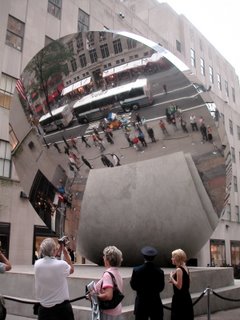 So the Rockefeller Center "Sky Mirror" will be installed till late October. But where will it go next?
So the Rockefeller Center "Sky Mirror" will be installed till late October. But where will it go next? Here's someone's pretty nice night shot of the "Sky Mirror" from Flickr, and here is Gothamist's coverage of it. Here's Kapoor at the Tate Modern.
Labels: art
2nd Avenue and 50th Street
 Last night whilst walking around with a friend in the Upper East Side, I swear we passed New York Times columnist Thomas Friedman. He's from Minnesota, you know. My friend and I had a couple drinks at Smörgås Chef, a favorite Scandinavian cafe of mine (with three locations!). We sat and watched as cops, often three per corner or more, halted traffic for diplomatic motorcades from this week's big U.N. meeting -- the one that the president is at. I took this picture of the street with the Citicorp Building in the background when we left.
Last night whilst walking around with a friend in the Upper East Side, I swear we passed New York Times columnist Thomas Friedman. He's from Minnesota, you know. My friend and I had a couple drinks at Smörgås Chef, a favorite Scandinavian cafe of mine (with three locations!). We sat and watched as cops, often three per corner or more, halted traffic for diplomatic motorcades from this week's big U.N. meeting -- the one that the president is at. I took this picture of the street with the Citicorp Building in the background when we left.
Rem Koolhaas at Cornell
Rem Koolhaas, the Dutch architect who designed the Seattle Public Library was in New York and in the Times to discuss his new project for Cornell University's Milstein Hall. One of the things I liked about Koolhaas's Seattle Library building -- especially compared to Frank Gehry's Experience Music Project (EMP), also in Seattle, was how deliberate it seemed, how well planned and clean. Gehry's EMP struck me as a design based on a crumpled blueprint, one with little thought about how to fill the interior space and no thought to dealing with the interior shape created by the wild exterior.
Talking about his designs for Cornell, Koolhaas said he was now a part of the blob versus box war in contemporary architecture, but that he was trying do something different. That made more sense when I read Cornell's own coverage of his talk there:
I actually think that the MoMA expansion is a functional success -- an underwhelming one -- but still, it works. But what Koolhaas observes about performance and effect is precisely the problem with the EMP.
Talking about his designs for Cornell, Koolhaas said he was now a part of the blob versus box war in contemporary architecture, but that he was trying do something different. That made more sense when I read Cornell's own coverage of his talk there:
Speaking of the trend toward dramatically shaped buildings, Koolhaas observed that cities are "stuck with a series of buildings that are supposed to be exceptional, but the way they perform is inferior to their effect." Whether it's the extravagance of the "Bilbao effect," said Koolhaas -- referring to the undulating surface of Frank Gehry's Guggenheim Museum in Bilbao, Spain -- or the "sobriety" of the newly expanded Museum of Modern Art in New York City, he said, "the public receives both with equanimity."The Bilbao museum is wrought of the same crumpled foil that Seattle's EMP is.
I actually think that the MoMA expansion is a functional success -- an underwhelming one -- but still, it works. But what Koolhaas observes about performance and effect is precisely the problem with the EMP.
"The most pernicious part of the Bilbao effect is that even major cities lose confidence and think they need extravagant buildings to remain interesting," Koolhaas said. He warned of the danger of architecture becoming "sloppy, uncritical. It's received with an enormous amount of attention and a negligible amount of seriousness."Judging by the shit I've seen built in New York, Minneapolis, Seattle, Boston, and a few other cities lately, I don't think anyone's really been thinking they have to build extravagant structures. If only we had such a problem! Still, he has a point.
The Edge Foundation's Big Questions
Richard Dawkins, Oxford University evolutionary biologist:
The Edge Foundation was founded in 1988 on C.P. Snow's idea that from the two cultures of literary intellectuals on the one hand and scientists on the other -- two groups that don't communicate nearly enough -- can emerge a third culture, one made up of both groups. John Brockman, founder of the Foundation wrote of it:
That's great, but wouldn't we all be better off with more people talking to each other? If not, I'm not only out of work, I'm irrelevant.
Thank god for Michael Nesmith then. You know, the former member of the Monkees? His "dangerous idea" is that the idea of existence as Non-Time, Non-Sequential, and Non-Objective, when used by the wrong mind, can be troublesome. Taking the an example, he says: "Non-Time drives forward the notion the past does not create the present. This would of course render evolutionary theory a local-system, near-field process that was non-causative (i.e. effect)." I don't actually find that very satisfying as a dangerous idea. What do you expect from a Monkee?
My favorite "dangerous idea" so far comes from Geoffrey Miller, Evolutionary Psychologist, University of New Mexico, who took physicist Enrico Fermi's 1940s era question to astronomers: if the universe is teeming with solar systems hospitable to life, where is everyone? and went beyond the typical "Perhaps extra-terrestrial intelligence always blows itself up" and came up with this:
So what's Miller's dangerous idea? That we'll get over our addictions with the help of religious conservatives and liberal environmentalists:
Last year's question was "What do you believe is true, even though you cannot prove it?" Returning to my worry that the Edge is cutting out literary intellectuals, I'm relieved to find novelist Ian McEwan answering. He believes that when he's dead, he's dead. And science fiction writer Bruce Sterling is in there. I'll quote him in full: "I can sum my intuition up in five words: we're in for climatic mayhem." Hmm. Maybe we shouldn't have literary intellectuals in here. They're too depressing.
"Retribution as a moral principle is incompatible with a scientific view of human behaviour. As scientists, we believe that human brains, though they may not work in the same way as man-made computers, are as surely governed by the laws of physics. When a computer malfunctions, we do not punish it. We track down the problem and fix it, usually by replacing a damaged component, either in hardware or software."That's from Dawkins' answer to the Edge Foundation's annual question for public intellectuals from 2006: "What Is Your Dangerous Idea?" Dawkins continues:
"Why do we vent such visceral hatred on child murderers, or on thuggish vandals, when we should simply regard them as faulty units that need fixing or replacing? Presumably because mental constructs like blame and responsibility, indeed evil and good, are built into our brains by millennia of Darwinian evolution.His dangerous idea is that we'll "grow out of all this."
The Edge Foundation was founded in 1988 on C.P. Snow's idea that from the two cultures of literary intellectuals on the one hand and scientists on the other -- two groups that don't communicate nearly enough -- can emerge a third culture, one made up of both groups. John Brockman, founder of the Foundation wrote of it:
"Although I borrow Snow's phrase, it does not describe the third culture he predicted. Literary intellectuals are not communicating with scientists. Scientists are communicating directly with the general public. Traditional intellectual media played a vertical game: journalists wrote up and professors wrote down. Today, third- culture thinkers tend to avoid the middleman and endeavor to express their deepest thoughts in a manner accessible to the intelligent reading public."Ironically, Brockman seems to backstep from Snow's idea of literary intellectuals and scientists communicating in exchange for a shift where the scientists are the new public intellectual. These are, according to the Foundation, "physicists, evolutionary biologists, philosophers, biologists, computer scientists, psychologists, social, behavioral, and anthropological scientists, and science journalists."
That's great, but wouldn't we all be better off with more people talking to each other? If not, I'm not only out of work, I'm irrelevant.
Thank god for Michael Nesmith then. You know, the former member of the Monkees? His "dangerous idea" is that the idea of existence as Non-Time, Non-Sequential, and Non-Objective, when used by the wrong mind, can be troublesome. Taking the an example, he says: "Non-Time drives forward the notion the past does not create the present. This would of course render evolutionary theory a local-system, near-field process that was non-causative (i.e. effect)." I don't actually find that very satisfying as a dangerous idea. What do you expect from a Monkee?
My favorite "dangerous idea" so far comes from Geoffrey Miller, Evolutionary Psychologist, University of New Mexico, who took physicist Enrico Fermi's 1940s era question to astronomers: if the universe is teeming with solar systems hospitable to life, where is everyone? and went beyond the typical "Perhaps extra-terrestrial intelligence always blows itself up" and came up with this:
"I suggest a different, even darker solution to Fermi'sAliens aren't exploring space because they're addicted to entertaining themselves.
Paradox. Basically, I think the aliens don't blow themselves up; they just get addicted to computer games. They forget to send radio signals or colonize space because they're too busy with runaway consumerism and virtual-reality narcissism. They don't need Sentinels to enslave them in a Matrix; they do it to themselves, just as we are doing today."
So what's Miller's dangerous idea? That we'll get over our addictions with the help of religious conservatives and liberal environmentalists:
"Those who persist will evolve more self-control, conscientiousness, and pragmatism. They will evolve a horror of virtual entertainment, psychoactive drugs, and contraception. They will stress the values of hard work, delayed gratification, child-rearing, and environmental stewardship.Now that is a dangerous idea.
...
"Christian and Muslim fundamentalists, and anti-consumerism activists, already understand exactly what the Great Temptation is, and how to avoid it. They insulate themselves from our Creative-Class dream-worlds and our EverQuest economics. They wait patiently for our fitness-faking narcissism to go extinct. Those practical-minded breeders will inherit the earth, as like-minded aliens may have inherited a few other planets."
Last year's question was "What do you believe is true, even though you cannot prove it?" Returning to my worry that the Edge is cutting out literary intellectuals, I'm relieved to find novelist Ian McEwan answering. He believes that when he's dead, he's dead. And science fiction writer Bruce Sterling is in there. I'll quote him in full: "I can sum my intuition up in five words: we're in for climatic mayhem." Hmm. Maybe we shouldn't have literary intellectuals in here. They're too depressing.
Monday, September 18, 2006
Being Tough on Langauage is to Hard
A friend in Minnesota alerted me to an e-mail he got from the office of Lori Swanson, the Democrat running for Minnesota. She's Smart, She's Tough, and She's on Your Side.
But her campaign e-mail said something odd in the subject line: "If Your Still Undecided..." It's tough to be smart when your mixing up you're yores.
My friend was feeling ornery so he shot off an e-mail to Lori HQ and got the following reply:
As an editor by profession, I'd like to add some professional advice:
1. Do as Ms. Swanson's office did and be gracious about being corrected.
2. Do as my friend did and a) check the rule to make sure you're right, and then b) tell the public personality that that they made a mistake. They need to know.
3. Never call yourself a langauge expert. Call yourself an enthusiast. We all make mistakes. And sometimes they get published.
Reminds me of an uppity woman name of Lynne Truss. Claimed to be tough on grammar and wrote a book about it. But Eats, Shoot & Leaves: The Zero Tolerance Approach to Punctuation got a nasty review in the New Yorker on account of its bad grammar. Part of it, to be fair, was that it was written for the U.K. audience, and they have different usage there. But Louis Menand found much more to quibble with than mere Britishisms:
There's another lesson, too. For every rule you think you know about English usage, there's an expert somewhere who has thought through why that rule isn't correct, necessary, or current.
A good example is that common supermarket checkout line sign: "10 items or less." When my dear mother pointed out how wrong that was ("less mashed potatoes, fewer peas," she said), it started to bother me whenever I saw it. And then Target changed their signs to "fewer." Many of us Minnesotans smiled every time we saw those Target signs. They seemed to confirm something about our shopping at Target: how un-Walmart this place is.
But Bill Walsh, copy editor at the Washington Post, makes an argument in his website The Slot that maybe "less" is okay. His claim is that the sign is short for "10 items or less than 10 items." He says that the sign would be wrong if it said "10 or less items" because then the "less" applies to the countable (items). I think what he's saying is that the sign we're used to is a shortened mathematical statement of the "greater than / less than" variety, which is okay. Agree with him or not (he says "10 items or fewer" sounds ridiculous), he's got a good argument.
I'm so distressed about apostrophes these days that when I see things like CD's and DVD's in the New York Times I get upset. But the apostrophes in those cases stand in for the missing letters -- it's an abbreviation: C[ompact ]D[isc]s. So it's not wrong, but we over-correct. Like when people say "and I" when they should be saying "and me."
I have a policy in this blog. Any reader who spots one of my typos or misuses or other language mistakes (the inadvertant ones, not my jokes like "speelcheck" or "yore") gets a prize. The friend who told me about Lori Swanson's campaign goof notified me of a typo in the description of this blog -- a mistake that sat there for about two months. No one said anything until he did. It gave me the idea: Let my readers be my editors. These goddamn blogs. They got no rules.
But her campaign e-mail said something odd in the subject line: "If Your Still Undecided..." It's tough to be smart when your mixing up you're yores.
My friend was feeling ornery so he shot off an e-mail to Lori HQ and got the following reply:
Thank you for pointing out the error in our last email--you are correct that the subject line should have read "you're," not "your." The volunteer who re-typed the subject line before the email was sent made an inadvertent error. The person has been volunteering such long hours in the closing days of this tight race that it has led to a lack of sleep and bleary eyes! Lori prides herself on taking care with the English language, and we appreciate that you took the time to point out the error to us.There's a lesson here: Edit yourself and then have at least one other person edit your writing.
Thanks again. We hope to earn your vote.
As an editor by profession, I'd like to add some professional advice:
1. Do as Ms. Swanson's office did and be gracious about being corrected.
2. Do as my friend did and a) check the rule to make sure you're right, and then b) tell the public personality that that they made a mistake. They need to know.
3. Never call yourself a langauge expert. Call yourself an enthusiast. We all make mistakes. And sometimes they get published.
Reminds me of an uppity woman name of Lynne Truss. Claimed to be tough on grammar and wrote a book about it. But Eats, Shoot & Leaves: The Zero Tolerance Approach to Punctuation got a nasty review in the New Yorker on account of its bad grammar. Part of it, to be fair, was that it was written for the U.K. audience, and they have different usage there. But Louis Menand found much more to quibble with than mere Britishisms:
The preface, by Truss, includes a misplaced apostrophe (“printers’ marks”) and two misused semicolons: one that separates unpunctuated items in a list and one that sets off a dependent clause. About half the semicolons in the rest of the book are either unnecessary or ungrammatical, and the comma is deployed as the mood strikes. Sometimes, phrases such as “of course” are set off by commas; sometimes, they are not. Doubtful, distracting, and unwarranted commas turn up in front of restrictive phrases (“Naturally we become timid about making our insights known, in such inhospitable conditions”), before correlative conjunctions (“Either this will ring bells for you, or it won’t”), and in prepositional phrases (“including biblical names, and any foreign name with an unpronounced final ‘s’ ”). Where you most expect punctuation, it may not show up at all: “You have to give initial capitals to the words Biro and Hoover otherwise you automatically get tedious letters from solicitors.”Some of Truss's goofs could have been prevented with simple fact-checking:
And it is stated that The New Yorker, “that famously punctilious periodical,” renders “the nineteen-eighties” as the “1980’s,” which it does not. The New Yorker renders “the nineteen-eighties” as “the nineteen-eighties.”Oh, it's hard being punctilious. Better not to say you are. Is that the cheap way out? Maybe. Bloggers have it easy. The medium is like the Wild West (should "wild" be capitalized there? Suddenly, I'm nervous) -- no need for editors, speelcheck or proper grammar.
There's another lesson, too. For every rule you think you know about English usage, there's an expert somewhere who has thought through why that rule isn't correct, necessary, or current.
A good example is that common supermarket checkout line sign: "10 items or less." When my dear mother pointed out how wrong that was ("less mashed potatoes, fewer peas," she said), it started to bother me whenever I saw it. And then Target changed their signs to "fewer." Many of us Minnesotans smiled every time we saw those Target signs. They seemed to confirm something about our shopping at Target: how un-Walmart this place is.
But Bill Walsh, copy editor at the Washington Post, makes an argument in his website The Slot that maybe "less" is okay. His claim is that the sign is short for "10 items or less than 10 items." He says that the sign would be wrong if it said "10 or less items" because then the "less" applies to the countable (items). I think what he's saying is that the sign we're used to is a shortened mathematical statement of the "greater than / less than" variety, which is okay. Agree with him or not (he says "10 items or fewer" sounds ridiculous), he's got a good argument.
I'm so distressed about apostrophes these days that when I see things like CD's and DVD's in the New York Times I get upset. But the apostrophes in those cases stand in for the missing letters -- it's an abbreviation: C[ompact ]D[isc]s. So it's not wrong, but we over-correct. Like when people say "and I" when they should be saying "and me."
I have a policy in this blog. Any reader who spots one of my typos or misuses or other language mistakes (the inadvertant ones, not my jokes like "speelcheck" or "yore") gets a prize. The friend who told me about Lori Swanson's campaign goof notified me of a typo in the description of this blog -- a mistake that sat there for about two months. No one said anything until he did. It gave me the idea: Let my readers be my editors. These goddamn blogs. They got no rules.
Sunday, September 17, 2006
Fake Magazine Covers
 I didn't notice when I wrote my little Vanity Fair entry a day or two ago that there was another gem inside the thick ad-infested September issue. I found this when I stumbled upon writer and designer Andrew Hearst's website, panopticist.
I didn't notice when I wrote my little Vanity Fair entry a day or two ago that there was another gem inside the thick ad-infested September issue. I found this when I stumbled upon writer and designer Andrew Hearst's website, panopticist. It's an ingenious bit of do-it-yourself magazine sabotage in the form of one of those cover flaps that you see at newsstands. Here we have a fake flap that you can cut out and fold over an issue of Bill Kristol's neo-conservative soap box, The Weekly Standard. Try it at home!
 Andrew Hearst has a whole section of his fake magazine covers which includes "Sementeen," "American Gentrifier," a creepy US Weekly cover designed like a Harper's cover, "Bad Touch Weekly" (with Michael Jackson on the cover), and, my favorite, a fake issue of Parents that started an Internet hoax.
Andrew Hearst has a whole section of his fake magazine covers which includes "Sementeen," "American Gentrifier," a creepy US Weekly cover designed like a Harper's cover, "Bad Touch Weekly" (with Michael Jackson on the cover), and, my favorite, a fake issue of Parents that started an Internet hoax. That ingenious cover was, as Hearst explains, never promoted as the real thing -- it was some bad Internet journalism that spread the rumor. It started when the blog Boing Boing referred to it as a real cover, and ended when Snopes.com debunked it, much to the amusement of Mr. Hearst.
Saturday, September 16, 2006
L.A. Times: The Masticator is a Narcissist
My friend and fellow blogger K writes that he scored "off the charts" on the L.A. Times Narcissistic Personality Inventory. Readers who know K won't be surprised that he scored very high -- he is an extrovert.
I'm a little puzzled by the test. I scored a 24 out of 40. Average is 15. Reality TV stars supposedly get a 19.45. So I'm up there a bit, too. As K points out, the test is little more than an amusement -- you have a series of forty opposing statements. Who of us is either one extreme or the other in every situation? Still, amusing.
I'm a little puzzled by the test. I scored a 24 out of 40. Average is 15. Reality TV stars supposedly get a 19.45. So I'm up there a bit, too. As K points out, the test is little more than an amusement -- you have a series of forty opposing statements. Who of us is either one extreme or the other in every situation? Still, amusing.
Esquire 1972
 I picked up an old copy of Esquire at a used bookstore in Chelsea today. I might have passed it by had it not been for the coverline: "Mrs. Spillane on Mickey Spillane." For $5 (A bit more than the cover price in 1972: $1 -- or 2006: $3.50; but still fair.) I got the August 1972 issue -- A Mr. R. Kopper of 117 West 13th Street's issue, to be precise.
I picked up an old copy of Esquire at a used bookstore in Chelsea today. I might have passed it by had it not been for the coverline: "Mrs. Spillane on Mickey Spillane." For $5 (A bit more than the cover price in 1972: $1 -- or 2006: $3.50; but still fair.) I got the August 1972 issue -- A Mr. R. Kopper of 117 West 13th Street's issue, to be precise. Esquire was known for two things back in the old days: great writing and great covers. This old issue is considerably more "wordy" than the issue I bought at the airport last week. There are a lot of columns -- Nora Ephron has a "Women" column and Peter Bogdonavich has one called "Hollywood." There are two stories, one by Borges and another by Malamud. Fiction is disappearing in magazines these days.
 Esquire's covers aren't as smart as they used to be, but some are well-done. September 2006 is forgettable. Esquire's website has a cover gallery showing every cover they ever did. There are some incredible ones, like February 1968's Roy Cohn cover (one of two; he also appeared ten years later.) which showed Senator Joe McCarthy's notoriously mean and notoriously gay henchman with a halo. Close up, without coverlines. It's a powerful image.
Esquire's covers aren't as smart as they used to be, but some are well-done. September 2006 is forgettable. Esquire's website has a cover gallery showing every cover they ever did. There are some incredible ones, like February 1968's Roy Cohn cover (one of two; he also appeared ten years later.) which showed Senator Joe McCarthy's notoriously mean and notoriously gay henchman with a halo. Close up, without coverlines. It's a powerful image.  Nixon is on twice, too. in May 1968 he appeared close up with eyes closed, in profile as four hands applied make-up. Again, a cover with no coverlines. Magazines these days can't help but to clutter covers with words to sell the contents. These older Esquire covers, the good ones at least, sold magazines with bold covers. Did they sell? Maybe it's been proven that coverlines sell issues. After all, I bought my 1972 issue because I saw Mickey Spillane's name (I'll get to him shortly).
Nixon is on twice, too. in May 1968 he appeared close up with eyes closed, in profile as four hands applied make-up. Again, a cover with no coverlines. Magazines these days can't help but to clutter covers with words to sell the contents. These older Esquire covers, the good ones at least, sold magazines with bold covers. Did they sell? Maybe it's been proven that coverlines sell issues. After all, I bought my 1972 issue because I saw Mickey Spillane's name (I'll get to him shortly). Both the Nixon and the Cohn covers were designed by the legendary ad man and sometime Esquire cover man George Lois. (He is also the guy who created the "I want my MTV" ad campaign, and the inventor of the "Lean Cuisine" line of "gourmet" frozen foods.)
 A few things about the old Esquire remains the same. In my September 2006 issue, we have a "Best Dressed List" that includes five regular chaps who won the magazine's "Best Dressed Real Men in America" contest and a celebrity list that includes Nick Cave, Jake Gyllenhaal, Terrence Howard, John Legend, Daniel Craig (the new James Bond).
A few things about the old Esquire remains the same. In my September 2006 issue, we have a "Best Dressed List" that includes five regular chaps who won the magazine's "Best Dressed Real Men in America" contest and a celebrity list that includes Nick Cave, Jake Gyllenhaal, Terrence Howard, John Legend, Daniel Craig (the new James Bond). In my August 1972 issue, we have "The 10 Best-Dressed Jocks," a list that includes cover boy Walt Frazier (New York Knicks), downhill skier Billy Kidd, tennis player Stan Smith, and, my favorite, Minnesota Vikings defensive end Carl Eller. The caption on Eller says he "wears a dashiki and slacks he designed himself, made by Elegantique. His high-laced boots are by Bela, a St. Paul bootmaker." He is pictured at left.
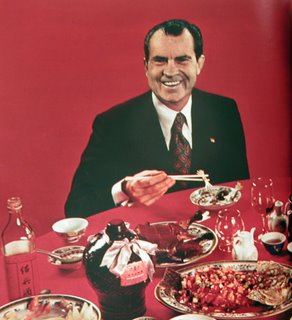 One of the stranger things in the August 1972 issue is an article called "How to Get a Great Chinese Meal in an American Chinese Restaurant" by Roy Andries de Groot. De Groot was an interesting character -- he was a blind food critic and culinary writer who lived in New York and shot himself in 1983. As a critic, he was very influential. His article in Esquire is just what the title says it is, and it's good. It's the accompanying photo of a grinning Dick Nixon amid myriad Chinese dishes that's strange. Of course, Nixon had, quite famously, just been in China in February of that year. But it remains a peculiar photo, perhaps because Nixon always looked peculiar, always looked uncomfortable and out of place. The caption for this two-page spread (of which I show only one) says:
One of the stranger things in the August 1972 issue is an article called "How to Get a Great Chinese Meal in an American Chinese Restaurant" by Roy Andries de Groot. De Groot was an interesting character -- he was a blind food critic and culinary writer who lived in New York and shot himself in 1983. As a critic, he was very influential. His article in Esquire is just what the title says it is, and it's good. It's the accompanying photo of a grinning Dick Nixon amid myriad Chinese dishes that's strange. Of course, Nixon had, quite famously, just been in China in February of that year. But it remains a peculiar photo, perhaps because Nixon always looked peculiar, always looked uncomfortable and out of place. The caption for this two-page spread (of which I show only one) says:"Each of these Chinese banquet dishes was served to President Nixon at one time or another during his trip to the mainland in February. Together, the comprise an ideal Chinese feast. You can taste them yourself in New York, San Francisco, or St. Louis by ordering the dinner in advance from one of the four great Chinese restaurants mentioned in the article."I haven't checked yet to see if any of those restaurants still exist.
And now, the reason I bought this magazine, Mickey Spillane. As I mentioned in an obituary post from July (Frank Morrison Spillane: 1918-2006), Spillane's second wife Sherri Malinou appeared on the cover of his attempt at a more literary novel, "The Erection Set." Here, in the August 1972 issue of Esquire, we have Mrs. Spillane née Malinou, profiled in a story called "That's no naked lady, that's Mickey Spillane's naked wife."
 Says the article:
Says the article:"Actually it was Sherri Spillane who had breathed, in approved Spillane heroine fashion, to her husband, "I want to be naked on the cover of your next book," and Mickey who had assented gruffly. "I was tired of dogs anyway."Apparently Spillane wrote her into the plot of "The Erection Set" as a sexually confident young character named Sharon. The profile is spare -- there isn't much to Mrs. Spillane, or her marriage for that matter. And that's why we have such a large, nude, photo.
But Up isn't Quite Down Yet
I read about the upcoming Swedish elections this morning in the New York Times and noticed that the beleagured right-wing of Swedish politics has a fancy plan to appeal to voters, voters who are already smarting from employment numbers. "The conservative party ... wants so much to appear not to be extreme that it calls itself the New Moderate Party," says the Times.
 It reminds me of Denmark's Ventsre Parti, their version of compassionate conservatism. "Venstre" means left, a funny name for a right-wing party, but it comes from the party's place in parliament -- they traditionally sat on the left side of the aisle. Or so I heard.
It reminds me of Denmark's Ventsre Parti, their version of compassionate conservatism. "Venstre" means left, a funny name for a right-wing party, but it comes from the party's place in parliament -- they traditionally sat on the left side of the aisle. Or so I heard.
But then, the first floor in many European countries is actually the second floor. Or our first is really the ground floor.
I live in a blue state now -- New York. I moved from another blue state -- Minnesota. That's right, isn't it? I mean left. I'm confused because in Sweden, red is the color for the Social Democrats, and blue is the color for the Moderates, which are actually conservatives. But by our standards (American), moderate may be conservative. Then again, even a conservative in those parts still supports the welfare state, which Americans think of as pretty left. So the conservatives are really far left democrats. I think. At least domestically.
Only a liberal (and a devotee of literary criticism) could revel in this much relativism, right?
 It reminds me of Denmark's Ventsre Parti, their version of compassionate conservatism. "Venstre" means left, a funny name for a right-wing party, but it comes from the party's place in parliament -- they traditionally sat on the left side of the aisle. Or so I heard.
It reminds me of Denmark's Ventsre Parti, their version of compassionate conservatism. "Venstre" means left, a funny name for a right-wing party, but it comes from the party's place in parliament -- they traditionally sat on the left side of the aisle. Or so I heard. But then, the first floor in many European countries is actually the second floor. Or our first is really the ground floor.
I live in a blue state now -- New York. I moved from another blue state -- Minnesota. That's right, isn't it? I mean left. I'm confused because in Sweden, red is the color for the Social Democrats, and blue is the color for the Moderates, which are actually conservatives. But by our standards (American), moderate may be conservative. Then again, even a conservative in those parts still supports the welfare state, which Americans think of as pretty left. So the conservatives are really far left democrats. I think. At least domestically.
Only a liberal (and a devotee of literary criticism) could revel in this much relativism, right?
Friday, September 15, 2006
Vanity Fair This Month
 I love Vanity Fair, but every time I get my issue in the mail (and it's always a good two damned weeks after it hits the newsstand), I have a ritual. I tear every card, perfume/cologne insert, thick-papered ad, and special section out. Anything that my thumb stops on when I rifle through the magazine is destroyed. I wonder how many others have this ritual with the thick-and-glossies. My tearing usually relieves the issue of at least a quarter-inch of the thickness.
I love Vanity Fair, but every time I get my issue in the mail (and it's always a good two damned weeks after it hits the newsstand), I have a ritual. I tear every card, perfume/cologne insert, thick-papered ad, and special section out. Anything that my thumb stops on when I rifle through the magazine is destroyed. I wonder how many others have this ritual with the thick-and-glossies. My tearing usually relieves the issue of at least a quarter-inch of the thickness. Why do I like Vanity Fair? Because it's edited by Graydon Carter, one of the founders (along with New York Magazine's Kurt Anderson) of Spy Magazine. Because it's one of the only fourteen places (along with The Nation. and Slate and The New Republic and The Atlantic) to read Christopher Hitchens. Etc.
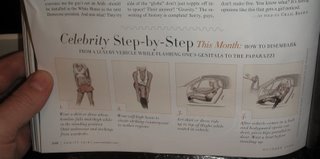 The last time I mentioned Vanity Fair in this blog I called attention to a Hitchens piece on fellatio. This time is no less bawdy. It's a diagrammed guide to exposing one's self whilst getting out of a luxury vehicle -- just for celebrities, females take note. For those of us who search the sordid side of the celebrity coverage on the Internet, this is well-timed. Go ahead, Google "celebrity up-skirt". It'll only ask you if you meant "celebrity upskirt". Ahh, Paris.
The last time I mentioned Vanity Fair in this blog I called attention to a Hitchens piece on fellatio. This time is no less bawdy. It's a diagrammed guide to exposing one's self whilst getting out of a luxury vehicle -- just for celebrities, females take note. For those of us who search the sordid side of the celebrity coverage on the Internet, this is well-timed. Go ahead, Google "celebrity up-skirt". It'll only ask you if you meant "celebrity upskirt". Ahh, Paris. Seriously though, if I click on the first result for the latter search, I get a saucy Deutsch message that reads: Die Seite kann nicht gefunden werden. Which sounds nasty, but actually seems to mean "the page cannot be found." Oh, stop!
Thursday, September 14, 2006
The Times on Editors
New York Times assistant managing editor Richard L. Berke answered some reader questions about the editorial process for the paper, including one about what the role of the editor is. The reader asks why do we need editors besides spelling and grammar?
Berke's answer is interesting. Here's a snippet:
Later he writes: "Even with out my own byline ... " Doesn't he mean without -- one word?
Some of his other answers to reader questions are odd, slightly off. Ironically, it may be that he didn't run his piece by another editor.
Berke's answer is interesting. Here's a snippet:
"Now that I'm an editor, I have an even clearer perspective. First off, while some reporters produce perfect copy that barely needs editing, you should see some of the drafts from other reporters. I won't name any names, but let's just say that some of our most enterprising and dogged reporters aren't necessarily as talented in the writing department, while some of our most skillful stylists aren't always the most energetic reporters. Not everyone can do it all, especially since the reporting and editing process is demanding work under intense deadlines. (Plus, the workload is only getting more challenging, with reporters expected to contribute to our web site.)"But his lenghty answer also included some odd editing. In the next paragraph he says "While most of the best ideas come from reporter ... " SHouldn't that says the reporter, or reporters?
Later he writes: "Even with out my own byline ... " Doesn't he mean without -- one word?
Some of his other answers to reader questions are odd, slightly off. Ironically, it may be that he didn't run his piece by another editor.
Wednesday, September 13, 2006
Rem Koolhaas's Seattle Public Library
 As I mentioned in previous posts, I'm in Seattle for a few days on business. I've been walking all over the city looking at stuff, including some interesting buildings. I have some unkind words for Microsoft founder Paul Allen's Experience Music Project, a strange lump of a museum designed by Frank Gehry -- just scroll down. But I was impressed with Dutch architect Rem Koolhaas's Seattle Central Library. It's everything Gehry's EMP isn't.
As I mentioned in previous posts, I'm in Seattle for a few days on business. I've been walking all over the city looking at stuff, including some interesting buildings. I have some unkind words for Microsoft founder Paul Allen's Experience Music Project, a strange lump of a museum designed by Frank Gehry -- just scroll down. But I was impressed with Dutch architect Rem Koolhaas's Seattle Central Library. It's everything Gehry's EMP isn't. Here, from the New York Times Magazine, is why:
"Koolhaas, despite his professed admiration for Gehry, is uncomfortable with buildings that, like the Guggenheim Bilbao, seduce by dazzling. He wants to arrive at beauty as a byproduct, not the goal, of the design process. He is suspicious of the wow factor. "I like to do things that on first sight have a degree of simplicity but show their complexity in the way they are used or at second glance," he says. Although he is not a pop-culture celebrity on the order of Gehry, within his profession Koolhaas is the more influential figure -- because he writes as provocatively as he designs and because his innovative style, unlike Gehry's metallic whorls, has not solidified into a one-of-a-kind signature. "We are flamboyant conceptually, but not formally," Koolhaas says. His firm is known for thoroughly researching and radically addressing a client's needs; this cerebral approach to design undergirds all of his work."
 Where Gehry is abstract and instinctual, Koolhaas's architecture is the result of theories made practical. Nothing in a Koolhaas building is accidental or capricious, even when the shapes are as playful as they are in the Seattle Library.
Where Gehry is abstract and instinctual, Koolhaas's architecture is the result of theories made practical. Nothing in a Koolhaas building is accidental or capricious, even when the shapes are as playful as they are in the Seattle Library.  Where Gehry's EMP building had unfinished ceilings, Koolhaas is self-conscious about what's finished and what isn't. In one part of the building, angled support beams are covered in sheetrock and neatly painted up to a certain height. The rest of the beam is exposed to its fire-proof insulation.
Where Gehry's EMP building had unfinished ceilings, Koolhaas is self-conscious about what's finished and what isn't. In one part of the building, angled support beams are covered in sheetrock and neatly painted up to a certain height. The rest of the beam is exposed to its fire-proof insulation. The views from the balconies in the ten story building are stunning. The angles created by the glass and steel diamond-pattern planes of the exterior walls intersecting are mesmerizing.


As I was standing outside the Elliot Bay Bookstore (why doesn't Minnespolis and St. Paul have a big bookstore this good?) getting ready to walk to the library, a cab driver saw me looking at my map and asked if I needed help finding anything. When I told him I was headed to the library, he told me where it was, the history of Seattle's five main libraries and how some of them burned down, that fact that the new one was earthquake-proof and some $20 million over budget, and that the one-mile trip there was a very nice cab ride. I declined the taxi, but we had a nice chat about libraries.
I don't know how this building will age, but it's much more dazzling than Gehry's EMP inside. And as Koolhaas had hoped, it stands up to scrutiny. The more you look, the more there is to see and be dazzled by. Gehry's building is an abstract artistic meditation on music and guitars. It's very personal, and I don't see it as completely realized. It strikes me as unfinished in both a theoretical and literal sense. Koolhaas's Seattle Public Library is a thoughtful and functional building that is also very beautiful. It's the succesful marriage of architectural theory and engineering.

Tuesday, September 12, 2006
Seattle Public Art: "Lot's Tribe"
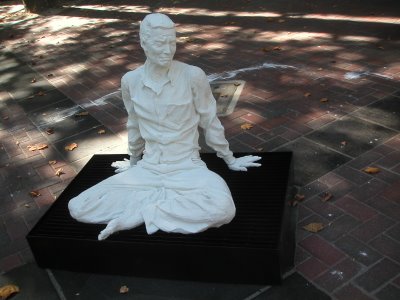 Seattle artist Michael Magrath's sculptures are made of salt. The life-size figures are modelled after Associated Press photos of suffering Iraqis, and they're intended to dissolve with the rain. I read about the sculpture set, called "Lot's Tribe," in Monday morning's Seattle Post-Intelligencer.
Seattle artist Michael Magrath's sculptures are made of salt. The life-size figures are modelled after Associated Press photos of suffering Iraqis, and they're intended to dissolve with the rain. I read about the sculpture set, called "Lot's Tribe," in Monday morning's Seattle Post-Intelligencer.  The sculpture pictured above is one of three. The other two are a boy squatting and a man holding his dead son. As art, they are beautiful pieces. The detailing is inhibited by the grainy quality of the salt in a way that makes the figures look wind-blasted and rugged. Almost like Pompeii's frozen figures. The rough material enhances the figures' beleaguered expressions.
The sculpture pictured above is one of three. The other two are a boy squatting and a man holding his dead son. As art, they are beautiful pieces. The detailing is inhibited by the grainy quality of the salt in a way that makes the figures look wind-blasted and rugged. Almost like Pompeii's frozen figures. The rough material enhances the figures' beleaguered expressions. When I visited the three sculptures in Seattle's Occidental Square near the UPS Waterfall Garden and the Elliot Bay Bookstore, people were walking around them, talking about them. People wondered how the sculptures would hold up in the first rain (expected soon) -- would they slowly melt, or would they, like Lot's wife in the bible, turn immediately to a pile of salt? I'm betting a small crowd will develop around the figures the next time it rains in Seattle.
Sculptures that disappear with rain are a brilliant conceit. The artist told the P-I's art critic:
"Lot's wife turned around to see something, and the sight froze her ... These people are in the midst of something that is changing their lives, but images from the war tend to wash over us. We see so many that we don't really see them anymore. In three dimensions, they last a little longer, but they won't last long."But what does it mean to have a set of sculptures unveiled in time for the fifth anniversary of the September 11 attacks, depicting Iraqi (and probably Muslim) war casualties, titled after a Christian bible story?
 Doesn't it conflate too many things? Iraq and Al Qaeda, 9/11 and the Iraq War, Christian and Muslim?
Doesn't it conflate too many things? Iraq and Al Qaeda, 9/11 and the Iraq War, Christian and Muslim? One of the most interesting things to me about P-I art critic Regina Hackett's coverage was that she didn't mention the bible. The story of Lot losing his wife to god's whimsy is a biblical one. Naming a piece of art showing suffering non-Christians after a bible story seems provocative or insensitive. But Hackett's article, by not invoking the bible, serves to secularize the story. My guess is that the sculptor is not a Christian, and that his intention was not to turn the Iraq War into a Christian versus Muslims issue, but the issues are there.
So what are we left with? A commentary on the fleetingness of war coverage and on the suffering of others while we mourn our own dead. That latter is a powerful statement, and one that is no less controversial than the religious one. It's something American liberals have been aching to point out to red state conservatives for five years: While New York lost 3,000 people, other parts of the world are racked with war and "sectarian violence" (to use a current news cliche), and they lose lives every day.
Implicit to liberals in that statement is that we have a responsibility to the world, that we're not the only important ones. Implicit to conservatives in that statement is that we deserved to be attacked. Liberals run the risk of being paternalsitic and conservatives run the risk of being self-absorbed.
I always say that any conversation about divisive issues is progress. I don't see that in America yet. I think we're still figuring out how to understand that idea that our island nation is penetrable. This set of sculptures is provocative, but I don't see anyone taking the bait.
Labels: art
Monday, September 11, 2006
The Birth of UPS
 Behold the birthplace of the United Parcel Service. Legend has it, Robert Johnson Parcel was cogitating on the top of falls here in downtown Seattle back in 1977. Mr. Parcel plummeted ten feet over the falls and when he arose from the frothy rapids, he had an idea: package deliverers whould wear brown uniforms.
Behold the birthplace of the United Parcel Service. Legend has it, Robert Johnson Parcel was cogitating on the top of falls here in downtown Seattle back in 1977. Mr. Parcel plummeted ten feet over the falls and when he arose from the frothy rapids, he had an idea: package deliverers whould wear brown uniforms.  And so UPS was born, right here in downtown Seattle.
And so UPS was born, right here in downtown Seattle. If only it were so. An alternate story, one most folks believe, is this, related by the Accidental Hedonist: "Waterfall Garden is a privately maintained park designed by Masao Kinoshita and built by the Annie E. Casey Foundation in 1977 to mark the birthplace of today's United Parcel Service. UPS co-founder James Casey got his start in 1907 serving a clientele largely made up of Pioneer Square's numerous saloons and brothels."
Quote of the Day
From this morning's USA Today:
"No one bats an eyelid at all the product placement in films or the sponsorship of (shows) on TV, so why should commercial novels be any different?"And
"Literary snobs might say otherwise, but all of the major literary prizes are sponsored by corporate money, so they don't mind taking the corporate (money) when it suits. I'd advise any writer to give it a go if the opportunity arises."That was Carole Matthews, author of The Sweetest Taboo, a chicklit novel that features the Ford Fiesta. Ford paid her "an undisclosed fee" to write the Fiesta into the plot.
Sunday, September 10, 2006
The Experience Music Project

The Masticator in Seattle continues with a tour of the Experience Music Project
I'll confess I went into the Experience Music Project with a bad attitude. I'm not a big fan of Frank Gehry's architecture, and all I could think about as I walked in was a pharmaceutical commercial in which a polished baby boomer in Dockers takes his son on an arm-pulling tour of the place.Is it a museum or a theme park? Ah, it's neither; it's a "project." Paul Allen, the cofounder of Microsoft and the (self-proclaimed) owner of the world's largest collection of Jimi Hendrix memorabilia commissioned architect Frank Gehry to design this "project" in the 90s. His sister Jody Patton runs the place.
Don't get the EMP (as they call it) confused (as I did) with ELP. That's Emerson Lake and Palmer. They're different.
The EMP is on a corner of the Seattle Center at the terminus of the monorail next to the Space Needle.
I think I would have had a very different "experience" of the EMP if I hadn't had to shell out $19.95 to get in. To be honest, I only paid the price of admission because I was under the impression that the high fee included admission to the exhibit called "Double Take: From Monet to Lichtenstein", an art exhibit that takes improbable pairings of art masterpieces and shows them side by side. It sounded ambitious. When I journeyed up the stairs of the cavernous project interior to the second floor, I was turned away from "Double Take" because I didn't have the correct pass: it was another $5. (looking at the website, it seems as though I could have paid a mere $8 to see only the "Double Take" exhibit. That certainly wasn't clear when I was there.) I was enraged.
I refused to pay any more to see what I had come to see, but I was determined to get my $19.95 worth out of the "project."
How do you make a museum about music? And how do you make it interactive? The "experience" part of the project is easy. There are recording booths with simplified drum sets, keyboards, and guitars for visitors to use, and that may be the most exciting part of the place.
But the project's exhibits, separate from the temporary "Double Take" show, can be summed up in one word: guitars. That's it. There's a multi-story column of guitars. There are guitars from many rock musicians. Guitars.
On the positive side, Gehry's building, part of which is the Science Fiction Museum and Hall of Fame ($12.95 admission or $26.95 for the SFM and the EMP both) is not like the Gehry building I'm most familiar with. Unlike Minneapolis's Wesiman Art Museum, the inside of the EMP relates to the outside's undulating shape. The interior spaces are shaped exactly like the outside structure.
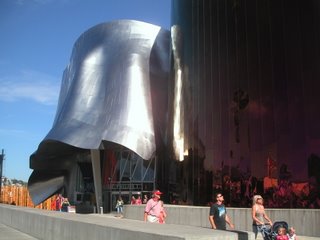 One of the reasons I'm not a fan of Gehry's work is not that he's a one trick pony (although he is); it's that I don't like that one trick. Some architects have signature styles, motifs or forms that always pop up in their work. For Santiago Calatrava the forms are arcs and fans inspired by his engineering background. I like that trick. Gehry's forms are crumpled tin foil. I don't like that one.
One of the reasons I'm not a fan of Gehry's work is not that he's a one trick pony (although he is); it's that I don't like that one trick. Some architects have signature styles, motifs or forms that always pop up in their work. For Santiago Calatrava the forms are arcs and fans inspired by his engineering background. I like that trick. Gehry's forms are crumpled tin foil. I don't like that one. But unlike the Weisman, where the crumpled tin foil is merely an exterior cladding bolted to a brick box, the EMP's exterior is structural. Unfortunately, it's awfully dark inside. Maybe the dimness is part of Paul Allen's rock and roll vision. I say the interior needs more light -- either natural or some very creative artificial light.
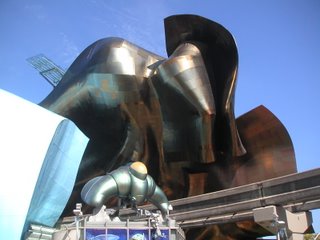 On the positive side again, it's challenging to walk around the building and try to wrap your mind around its shape. Even harder to snap a representative photo of it. The most inviting side, and the one facing the Space Needle (which is about 500 feet away), is the entrance to the Science Fiction Museum. That's too bad. I think it takes away from the rock and roll part to have the grandest entrance for the least known tenant.
On the positive side again, it's challenging to walk around the building and try to wrap your mind around its shape. Even harder to snap a representative photo of it. The most inviting side, and the one facing the Space Needle (which is about 500 feet away), is the entrance to the Science Fiction Museum. That's too bad. I think it takes away from the rock and roll part to have the grandest entrance for the least known tenant. The Interior
The third floor has a really nice concert poster exhibit, one based on the 2004 coffee table book Art of Modern Rock: The Poster Explosion. But as I walked through the exhibit, I was still disappointed. I realized why:1. I was still bitter about spending $20 to get into a museum about nothing.
2. No matter how interesting the exhibits are, the building always distracts you from its contents. The structure competes with the stuff inside and it always wins.
But that's what you do when you have lots of money and lots of will to realize an empty idea or a lackluster collection. Ask the Getty in Los Angeles. They took a galactic-sized endowment and a mediocre collection and came up with a remarkable building (designed by Richard Meier). And it's free.
Another thing you can do if you don't have a good collection is borrow from other museums. Or even -- as the EMP does with "Double Take" -- exhibit something far outside your jurisdiction.
The interior doesn't deal well with its exposed guts. The post-industrial style we're used to these days -- exposed air ducts and all of the other stuff that's visible when the acoustical panel dropped ceilings are removed -- does not translate well to this structure. At its best, the post-industrial interior style lays bare a building's inner workings. It shows us function without adornment.
Since the EMP is all form -- the wacky curves the antithesis of function -- exposing the ducts, using stage lights on suspended bars, and showing the insulation clad twisted I-beams makes the building actually look unfinished.
Baby Boomer Self Indulgence
This museum is the sort of overblown monument to one man's whims that can only happen -- and subsist -- in a good economy. A baby boomer economy so enamored of its own reflection that it can pay $19.95 for a museum without a concept housed in a building that looks like it was inspired by the crumpled up blueprint for a better idea.Another way to sum up the museum -- oops, it was a project, right? -- is with its On Stage section where you can "Be a rock star - even if you've never played an instrument!" It's a rock star simulation that "transports you to the center stage of a large arena, complete with smoke, hot lights and screaming fans." You can buy a souvenir DVD of your performance.
This, like the project and the building that houses it, is much ado about nothing, or, an embarrassing celebration of the uniquely American notion of individuality. Who do we think we are? Stars, each and every one. But the problem is -- forgive my latent judgmental Norwegian bachelor farmer side -- we're not all superstars. We're schlubs from rural Idaho. We're middle managers from the heartland, here on junket. We're accountants trying to show our wide-bottomed dates that we have a wild side. We're not special.
In America, money can buy you a lot. But it's no substitute for good ideas. If a billionaire wants to make a giant tin foil tent to house some guitars he bought off the estate of a dead rock star, and then overcharge tourists for the privilege of experiencing it, he can.
To enjoy this project you have to buy into the idea that we are all stars. That the baby boom generation's self absorption and conspicuous consumption are worth celebrating.
The Biggest failure of All: The Gift Shop
If you do buy into the concept of the EMP, the biggest failure for you will be the project's inability to sell you stuff. Surely a museum about experiencing music ought help you experience (or hear) music long after your visit is over. It should be the region's biggest retailer of CDs, concert DVDs, posters, and rock star biographies. Maybe even some musical instruments.The EMP's gift shop was light and airy with a lack of meaningful merchandise. Very few CDs. Very few posters. Plenty of personalized EMP coffee mugs. A sorry selection of sunglasses made me think of how great it would be if the gift shop sold replicas of rock star shades. They could be selling Elvis glasses, Elton John glasses, John Lennon glasses, etc.
What I'm saying is that if you fail as a museum, you can at least succeed as a retail shop. The EMP misses a huge opportunity here.
Conclusion
I understand that I'm not the target audience for this project. I'm a museum person and this isn't a museum. It's a project, something closer to a Disney imagineering of rock and roll history. It's for the guy in the drug commercial I mentioned in the beginning of this review: a regular family man with disposable income who wants to tell his children about his music. The project seems designed to do just that.But I'm not out of line criticizing a building doesn't relate to its contents (in spite of Gehry's statements about the museum being inspired by smashed guitars), that in fact overpowers its meager contents and fails to adjust its interior spaces to the shapes and problems its radical exterior creates.
As a solution to this building, an antidote if you will, I would pose Rem Koolhaas's amazing Seattle Public Library, a building that takes its contents and its purpose into account to create a stunning space, inside and out. It's as radical a design as Gehry's, but it's much friendlier to look at outside and to be in, inside. More on that later.
The Masticator in Seattle
 I'm in Seattle for a few days on business. I've never been here before, but I have some roots here -- my great grandparents on one side settled in the Seattle-Tacoma area from Norway in the early twentieth century. Walking this city, I'm struck by how much it resembles Oslo -- both are built up in hills overlooking fjords (or fjord-like bodies of water). Both are very green.
I'm in Seattle for a few days on business. I've never been here before, but I have some roots here -- my great grandparents on one side settled in the Seattle-Tacoma area from Norway in the early twentieth century. Walking this city, I'm struck by how much it resembles Oslo -- both are built up in hills overlooking fjords (or fjord-like bodies of water). Both are very green. I got a Sunday newspaper outside my door: The Seattle Post-Intelligencer. It's a name so awkward that some people think it's some kind of jab at our president. It looks like a decent enough rag. Little odd to be a new New Yorker reading about 9/11 in a paper from the opposite coast though.
Actually, upon closer inspection, the Sunday paper is both the Seattle Times and the Seattle Post-Intelligencer. The P-I started in 1863, according to the website, and the Times started in 1896. The Times is the bigger paper. While the two papers have separate ownership, the Times handles marketing, circualtion, production, and advertising for the P-I. Which seems like a conflict of interest. Apparently they do a joint Sunday paper. I don't get it.
There are a lot of companies from Seattle. I thought Nike was here, but it turns out it's Beaverton, Oregon. NikeTown is here -- but that's just a giant store. Boeing was headquartered here, but they moved to Chicago. Microsoft is around here though. And of course Starbucks.
One Post-Intelligencer headline says that although there are more than 100 Starbucks stores in Seattle, small coffee shops still do well. The little guys apparently acknowledge Starbucks' role in making the $5 cup of coffee the norm -- something they say keeps them all in business.
 There's a "landmark" Starbucks store in Pike's Market here in Seattle, the legendary first store. I visited the store, but I didn't buy anything. In a world with endless coffee possibilities, I can afford to be an elitist and say that I don't like their coffee.
There's a "landmark" Starbucks store in Pike's Market here in Seattle, the legendary first store. I visited the store, but I didn't buy anything. In a world with endless coffee possibilities, I can afford to be an elitist and say that I don't like their coffee. In the business section of the paper (the Times this time), there's an article on Starbucks expansion that says the coffee company is worried about having the same problems McDonald's did getting huge.
The very premise is absurd to New Yorkers, and I would guess Londoners would agree: Starbucks, which in those two cities sometimes has stores across the street from each other is worried about over-expanding? McDonald's grew by at least one store per day from the 1972 to 2002. Starbucks has about 12,000 stores now (8,600 in America), and they want 30,000. They are now opening five stores per day. They now have one store for every 11,000 people in Washington State.
I'll be writing more about my Seattle trip in the next couple of days.
